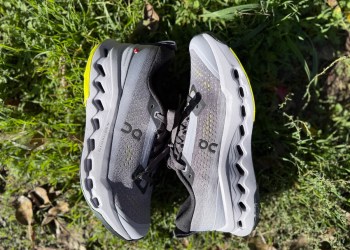“], “filter”: { “nextExceptions”: “img, blockquote, div”, “nextContainsExceptions”: “img, blockquote, a.btn, a.o-button”} }”>
New perk: Easily find new routes and hidden gems, upcoming running events, and more near you. Your weekly Local Running Newsletter has everything you need to lace up!
>”,”name”:”in-content-cta”,”type”:”link”}}”>Subscribe today.
Move over, Super Bowl Sunday. The Millrose Games stole the show this weekend with two indoor world records, two American indoor high school records, and one American indoor record.
We all knew there would be a football game played, with a winner and a loser, in New Orleans last weekend. But no one could have known that Grant Fisher would outkick countryman and fellow Olympic medalist Cole Hocker to set the indoor 3,000-meter world record in a time of 7:22.91. It was such a good race that both men actually broke Lamecha Girma’s 2023 mark.
The surprises continued an hour later when another American bronze medalist Yared Nuguse held off countryman Hobbs Kessler to break the indoor mile world record, with a time of 3:46.63, just barely dipping underneath Yomif Kejelcha’s longstanding mark from 2019.
Neither world record was expected—from fans, or from this young bunch of American men themselves.
But what really sets the Millrose Games apart from the Big Game is that while Super Bowl LIX was light on competition (the Philadelphia Eagles trounced the Kansas City Chiefs 40-22), these historic races were only made possible thanks to it.
Who Cares About the 3,000? We All Should
No, the 3,000 meters isn’t two miles. And no, it’s not held at the Olympics nor at the world championships. But that’s a tragedy and here’s why: It’s the perfect distance, the common ground for middle-distance and distance stars to settle the score. It’s long enough for drama to unfold, and short enough for the TikTok attention span. And lucky for us, it’s an event at the Millrose Games.
Case in point: The track world has craved a head-to-head competition between Grant Fisher and Cole Hocker since Fisher won bronze in the 5,000 meters and 10,000 meters and Hocker won gold in the 1500 meters last summer in Paris. Apparently they were both as thirsty as us.
Fisher, 27, rarely drops below the 5,000. But he expressed before the race that he was looking forward to a quality duel with Hocker, the 23-year-old reigning Olympic gold medalist. On a really good day, Fisher surmised, he might be able to take a crack at the American record of 7:28.23.
Boy was he wrong.
After a spicy-but-somewhat predictable opening 2,000 meters, Hocker surprised everyone, including Fisher, by taking the lead with three laps (600 meters) to go. Fisher locked onto his tail. Things were not looking good for Fisher when he unsuccessfully tried to move around Hocker with 150 to go. But pulling a leaf out of Hocker’s playbook, Fisher ultimately unleashed a lethal kick coming down the final straightaway to which Hocker had no answer. That’s a disgusting 3:58 minute per mile pace for just shy of two miles.
But it was only Fisher with his winning time of 7:22.91 who took home the $25,000 world record bonus (and presumably sponsor bonuses that likely far eclipsed that number).
“I think we brought the best out of each other. There’s no way I would have run that quick without Cole,” Fisher told reporters after the race. “I think we both wanted to come out and fight. That’s what the sport’s all about.”
But We All Care About the Mile, Right?
The Wanamaker Mile—the crowning jewel of the Millrose Games, named after the department store that founded the track meet in 1908—was looking pretty anticlimatic after 2023 world 1500-meter champion and 2024 Olympic 1500-meter silver medalist Josh Kerr of Great Britain withdrew thanks to an overnight illness on Saturday morning.
Meanwhile the path for Olympic 1500-meter bronze medalist Yared Nuguse, 25, of the U.S. to win his third Wanamaker title was looking pretty clear. (Never mind that Olympic 1500-meter fourth place finisher and American Hobbs Kessler, 21, was also in the field.) Kerr or no Kerr, Nuguse’s plan remained the same: go to the front and grind.
Like the 3,000, the mile isn’t a world championship event (though its spritely brother, the 1,500, is). It’s a shame that the mile isn’t run at the Olympics and world championship events because it’s the one distance all Americans, runners or not, can understand—thanks to those infernal mile time trials in high school gym class. And, as we saw on Saturday, those extra 609.34 meters beyond the 1500 mark are almost always where the lactate soup magic happens.
Pacemaker Abe Alvarado took it out hot, quickly stringing the pack of 11 behind him with Nuguse, followed by Kessler, on his heels. They came through the 400 just under world record pace. Alvarado pulled off the track with three laps to go, leaving the loping stride of Nuguse to take the lead.
That’s Nuguse’s happy place, and his loping stride looked relaxed until the bell with a slightly grimacing Kessler still tucked in behind. That grimace came out in full force on both Kessler and Nuguse over the final lap. Fueled by Kessler breathing down his neck from behind and the clock ticking towards the world record mark of 3:47.01 set by Ethiopian Yomif Kejelcha in 2019 from ahead, Nuguse let “the goose fully on the loose” in a bundle of swinging arms and legs and pain before leaning into the tape and stopping the clock in a blistering 3:46.63.
Like in the 3,000, second-place finisher Kessler’s presence in this race played an instrumental role in Nuguse earning that $25,000 world record bonus check. Yes, the rabbit was critical, too. But Kessler willing Nuguse on when the going got tough made all the difference—both for the race times, and our enjoyment as fans. (Kessler, by the way, also dipped under the old world record with a 3:46.90.)
All that was missing was a little crip walking during a halftime show.
Speaking of High School Glory Days…
Buried in the pro results were three more record-setting performances at marquee distance events.
American Josh Hoey stole the show in the 800, running fearlessly off the front to set the American record in 1:43.90. But riding on his coattails was high school sophomore phenom Cooper Lutkenhaus (Justin Northwest HS, TX) who held on just long enough to break none other than Hoey’s own American high school record by running 1:46.86.
That time is still slightly off the outdoor American high school mark, it’s also the first time a high schooler has broken 1:47 indoors.
Literally in the next event of the night, Sadie Engelhardt —the high school senior from Ventura, CA, who signed an NIL deal with New Balance in 2023—was able to capitalize on an otherwise-tactical, crowded, and chaotic women’s Wanamaker Mile. Engelhardt’s new American high school indoor mile record of 4:27.97 broke the longest-standing major distance record of the day, Mary Cain’s mark from the 2013 Millrose Games.
The 2025 Millrose Games Records, At A Glance:
Name
Time
Previous Indoor
Outdoor
Men’s Indoor Mile World Record
Yared Nuguse
3:46.63
3:47.01 (2019)
3:43.13 (1999)
Men’s Indoor 3,000-Meter World Record
Grant Fisher
7:22.91
7:23.81 (2023)
7:17.55 (2024)
Men’s Indoor 800-Meter American Record
Josh Hoey
1:43.90
1:44:21 (2021)
1:41.67 (2024)
Girls’ Indoor American High School Mile Record
Sadie Engelhardt
4:27.97
4:28.25 (2013)
4:28.46 (2024)
Boys’ Indoor American High School 800-Meter Record
Cooper Lutkenhaus
1:46.86
1:47.67 (2018)
1:46.45 (1996)














